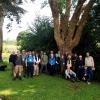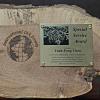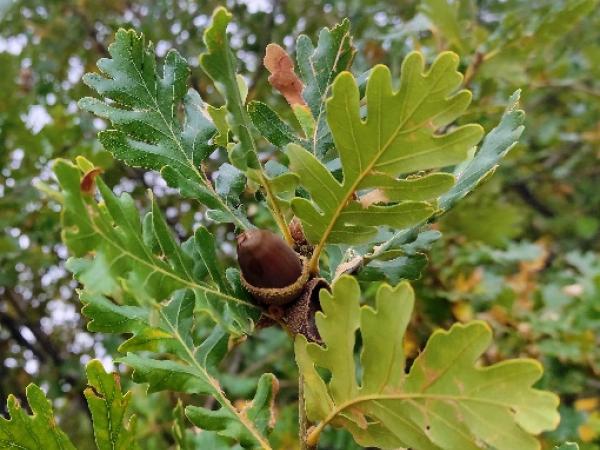Editor's Picks
Plant Focus
Quercus ithaburensis Decne. is a deciduous oak species native to the East Mediterranean basin. Taxonomists describe two different subspecies that are geographically separated: Q. ithaburensis subsp. macrolepis (Kotschy) Hedge & Yalt., known as vallonea oak, which is present in the north east of the Mediterranean basin (Turkey, Greece, and southeastern Italy), and Q. ithaburensis subsp. ithaburensis, known as Palestine oak or Tabor oak, the subspecies that is present in the Levantine countries within the Eastern Mediterranean basin (Palestine, Israel, Jordan, Syria, and Lebanon) and which is the concern of this article.[1]

Tabor oak trees are rounded and hemispherical, reaching 15 m in height. The trunk is corky with many protuberances. Branches are grey and form a spreading habit. The young shoots are hairy, soft, and grey. Buds are ovoid, with suppressed hairy scales. The leaves are broad-ovate, leathery with teeth, semipersistent, and late to fall. The acorns are solitary or in a cluster of 2 or 3. The cupule is large in diameter (3.5 cm), and the scales are thick, lanceolate, and recurved. The nut (gland) is longer than the cupule (5 cm). The size of the nut, the percentage of the covered part, the cupule diameter, and the size of the scales are key traits that differentiate the subspecies.

Q. ithaburensis is one of the southernmost deciduous oak species in the Eastern Mediterranean basin. Its altitudinal range goes from below sea level (Jordan Valley) up to 600 m, and rarely above this limit. The species is considered drought tolerant and thermophilic. Its root system is shallow and cannot tolerate heavy soils. Tabor oak thrives mainly in mature deep soils, whether basaltic or limestone, and consequently its habitat is mainly fertile plains and plateaus, like the Sharon Plain, Lower Galilee, and the Jordan Valley, in Israel, Palestine and Jordan, as well as the Lower Litani watershed and the Akkar plateau on the coastal zones of Lebanon and Syria.

This species grows mostly in open forests or Mediterranean scrubland. Tabor oak is a sun-loving species, and trees are seldom found isolated or grouped in small clusters, rarely mixed with other oak species like Quercus coccifera subsp. calliprinos or Q. infectoria, and other accompanying species like Styrax officinialis, Pistacia palaestina, Pyrus syriaca, and Crataegus azarolus var.aronia.
Most forests of Tabor oak are found in fertile plains along the coast; consequently, the species has suffered since the Neolithic from the reduction of its area of occupancy and reduction in the size of its population, due to human settlements and agricultural expansion in these coastal zones.

In addition to its reduced area of occurrence, Tabor oak suffers also from low regeneration rate caused by several factors including pest outbreaks, low acorn productivity, and overgrazing. However, trees are kept to provide shade for shepherds, and are rarely pruned for fuel wood or grazing. Many monumental trees are preserved near religious sites (churches, mosques, or graveyards). In the past Tabor oak was also planted as a supplementary food source, because of its very large and sweet acorns, and the cupules were largely used for dye industries until the beginning of the 20th century.

This species merits more attention in regard to its conservation, by reintroducing it into the farming systems (agroforestry) and by protecting the few remaining remarkable forests of Tabor oak in the Levantine countries.

Further reading:
Davis P.H. Flora of Turkey and the East Aegean Islands, Vol. 7. Edinburgh: Edinburgh University Press, 1982.
Dufour-Dror J.M., and A. Ertas. Bioclimatic perspectives in the distribution of Quercus ithaburensis Decne. subspecies in Turkey and in the Levant. Journal of Biogeography, 31 (2004), 461–474.
Mouterde, P. Nouvelle flore du Liban et de la Syrie. Vol 1. Beyrouth: Editions de l’Imprimerie Catholique, 1966.
Post G. Flora of Syria, Palestine and Sinai, Vol. 2. Beirut: American University of Beirut Press, 1932.
Sattout E. and H. Zahreddine Native Trees of Lebanon and Neighboring Countries: A Guidebook for Professionals & Amateurs. Louaize: Notre Dame University Press, 2013.
Stephan J., L. Chayban, and F. Vessella. Abiotic factors affecting oaks distribution in Lebanon. Turkish Journal of Botany, 40 (2016): 595-609. DOI: 10.3906/bot-1601-24.
Zohary M., and N. Feinbrun-Dothan. Flora Palaestina, Vol. 1. Jerusalem: The Israel Academy of Sciences and Humanities, Goldberg’s Press, 1966.
Photos: © Jean Stephan















